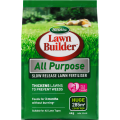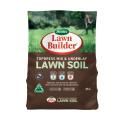When you are confronted with a large area that's to become a lawn, the scale of the project and the potential cost can both be rather daunting.Growing lawn from seed is a simple and budget-friendly way to create your dream lawn.
This project is not difficult but you need to think about a few important details:
- Understanding your site
- Deciding what you want from your lawn - bowling green perfection or tough grass for family play
- Choosing the right type of grass seed
The real secret to a quality lawn is making sure you know exactly what you want before you start.
Planning your new lawn
Make sure you pick the right grass variety for your needs and location. There are also a few other things to consider as you plan and prepare for your new lawn.
- Evaluate your lawn area: Is it shady, sunny or somewhere in-between?
This will determine the type of grass seed you can use. - Lawn use is an important consideration: If your lawn will receive lots of wear and tear, choose a seed variety that will recover well.
- Access to your garden and home are essential: If you seed the entire front lawn in one go, you may have effectively painted yourself into a corner! Break large areas up into two or more projects.
- Renovating or building? If your new lawn is part of new landscaping during or after construction, leave an area clear for trades to access the property, then plant this last when the rest of the work is complete.
Preparing to sow a new lawn
You will need:
- Spade
- Shovel
- Heavy hoe
- Landscape rake
- Petrol driven cultivator or rotary hoe (optional)
- Wheelbarrow
- Soil spreader (optional)
- Fertiliser/seed spreader
- Scotts Lawn Builder Lawn Soil
- Scotts Lawn Builder Lawn Seed blend to suit your needs
Step 1
Lawns are best sown in early spring and early autumn. Clear the area to be sown by spraying weeds and removing existing debris and grass.
Step 2
For a smaller area blend through Scotts Lawn Builder Lawn Soil to improve soil and fill dips. For a larger area talk to your local landscape supplier about suitable bulk soil mixes. Once spread and blended prepare a firm, level bed by raking the soil and then lightly rolling to compact.
Step 3
Sow lawn seed evenly at a rate of 25g per m2. Sow in a north-south direction and then again in an east-west direction to ensure complete, even coverage.
Step 4
Lightly rake to cover the seed. Water gently and keep damp until germination is completed. Your lawn will benefit from regular watering, particularly in drier months.
TIPS:
- If your soil is a heavy clay, add gypsum and washed river sand to open up the soil structure so roots and moisture can penetrate better.
- On a sandy soil, add Debco Saturaid Granular Soil Wetter and blend through Scotts Lawn Builder Lawn Soil to improve soil structure and moisture retention.
- Apply Scotts Lawn Builder Seed & Turf Starter granular lawn food at the recommended rate during the soil preparation stage.
- When improving soil: Don’t just spread a new layer of soil on top of the old. This will lead to distinct soil layers and may create zones where water pools or does not soak in.
It’s bit more work, but blend the new soil with the existing soil. This simple but important task can be as easy as vigorous raking with a landscape rake before levelling.
Lawn maintenance and aftercare
Your new lawn needs lots of attention until it is thick and lush.
For more about ongoing care, read our informative articles on feeding and improving your lawn.










